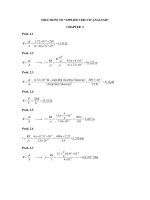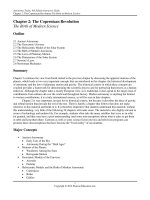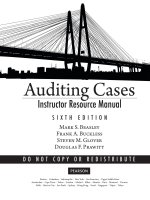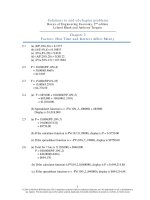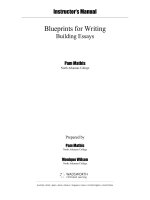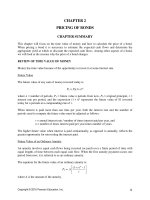Solution manual of chemical bassic of life
Bạn đang xem bản rút gọn của tài liệu. Xem và tải ngay bản đầy đủ của tài liệu tại đây (425.07 KB, 11 trang )
2
LIFE’S CHEMICAL BASIS
Chapter Outline
2.1 WHAT ARE THE BASIC
BUILDING BLOCKS OF ALL
MATTER?
Isotopes and Radioisotopes
Tracers
2.2 WHY DO ATOMS INTERACT?
Electrons Matter
About Vacancies
2.3 HOW DO ATOMS INTERACT IN
CHEMCICAL BONDS?
Ionic Bonds
Covalent Bonds
2.4 WATER’S ARE LIFE-SUSTAINING
PROPERTIES OF WATER?
Hydrogen Bonding in Water
Water's Special Properties
2.5 WHY ARE HYDROGEN IONS
IMPORTANT IN BIOLOGICAL
SYSTEMS?
2.6 MERCURY RISING
SUMMARY
SELF-QUIZ
DATA ANALYSIS ACTIVITIES
CRITICAL THINKING
Life’s Chemical Basis
Learning Objectives
2.1 Describe a few properties of atoms and elements.
2.1.1 What is an atom composed of?
2.1.2 What is an element?
2.1.3 Describe how atoms are arranged in the periodic table.
2.1.4 What are isotopes?
2.1.5 Explain how radioisotopes can help scientists to measure the age of a fossil.
2.1.6 How are radioisotopes used as tracers to study biological processes?
2.2 Describe the arrangement of electrons in atoms.
2.2.1 Explain how electrons are organized in orbitals.
2.2.2 Explain the shell model of electrons with an example.
2.2.3 Why do some elements occur in nature as solitary atoms?
2.2.4 Why are atoms with vacancies said to be chemically reactive?
2.2.5 Define free radicals and explain why they are dangerous to life.
2.2.6 How do atoms become ions?
2.3 Describe the different types of chemical bonds.
2.3.1 Define a chemical bond.
2.3.2 With the help of suitable examples, distinguish between ionic and covalent
bonds.
2.3.3 Define polarity and explain why ionic bonds are extremely polar.
2.3.4 What is electronegativity and what does it depend on?
2.3.5 Describe how covalent bonds between atoms are represented.
2.3.6 Distinguish between polar and nonpolar covalent bonds with examples.
2.4 Describe the properties that liquid water acquires due to hydrogen bonding.
2.4.1 Draw the hydrogen bond between two water molecules.
2.4.2 Describe the nature of a hydrogen bond.
2.4.3 Why is water a good solvent?
2.4.4 Describe the mechanism by which different kinds of substances dissolve in
water.
2.4.5 Distinguish between hydrophilic and hydrophobic substances.
2.4.6 Why do oils not mix with water?
2.4.7 Why does evaporation cause cooling?
2.4.8 Explain how the movement of water molecules varies with temperature.
2.5 Describe the importance of maintaining the pH of a biological system.
2.5.1 What is pH?
Chapter Two
2.5.2 Differentiate between acids and bases.
2.5.3 Differentiate between strong acids and weak acids with examples.
2.5.4 Explain how buffers maintain the pH of solutions.
2.5.6 Explain why it is important to maintain the pH of biological systems within a
consistent range.
2.6 Describe the consequences of exposure to methylmercury.
2.6.1 How do humans get exposed to methylmercury?
2.6.2 What are the harmful health effects of methylmercury consumption?
Key Concepts and Terms
1. Key Concept: Atoms and Elements
Atoms, the building blocks of all matter, differ in their numbers of protons,
neutrons, and electrons. Atoms of an element have the same number of protons.
Take-Home Message 2.1
All matter consists of atoms, tiny particles that in turn consist of electrons moving
around a nucleus of protons and neutrons. An element is a pure substance that
consists only of atoms with the same number of protons. Isotopes are forms of an
element that have different numbers of neutrons. Unstable nuclei of radioisotopes
break down spontaneously (decay) at a predictable rate to form predictable
products.
Key Terms
atomic number Number of protons in the atomic nucleus; determines the
element.
charge Electrical property. Opposite charges attract, and like charges repel.
electron Negatively charged subatomic particle.
element A pure substance that consists only of atoms with the same number of
protons.
isotopes Forms of an element that differ in the number of neutrons their atoms
carry.
mass number Of an isotope, the total number of protons and neutrons in the
atomic nucleus.
neutron Uncharged subatomic particle in the atomic nucleus.
nucleus Core of an atom; occupied by protons and neutrons.
periodic table Tabular arrangement of all known elements by their atomic
number.
proton Positively charged subatomic particle that occurs in the nucleus of all
atoms.
radioactive decay Process by which atoms of a radioisotope emit energy and/or
subatomic particles when their nucleus spontaneously breaks up.
radioisotope Isotope with an unstable nucleus.
tracer A molecule with a detectable component.
2. Key Concept: Why Electrons Matter
Whether and how an atom interacts with other atoms depends on the number of
electrons it has. An atom with an unequal number of electrons and protons is an ion.
Take-Home Message 2.2
An atom’s electrons are the basis of its chemical behavior. Shells represent all
electron orbitals at one energy level in an atom. When the outermost shell is not full
of electrons, the atom has a vacancy. Atoms with vacancies tend to interact with
other atoms.
Key Terms
free radical Atom with an unpaired electron.
ion Charged atom.
shell model Model of electron distribution in an atom.
3. Key Concept: Atoms Bond
Atoms of many elements interact by acquiring, sharing, and giving up electrons.
Interacting atoms may form ionic, covalent, or hydrogen bonds.
Take-Home Message 2.3
A chemical bond forms between atoms when their electrons interact. A chemical
bond may be ionic or covalent depending on the atoms taking part in it. An ionic
bond is a strong mutual attraction between two ions of opposite charge. Ionic bonds
are very polar. Atoms share a pair of electrons in a covalent bond. When the atoms
share electrons unequally, the bond is polar.
Key Terms
chemical bond An attractive force that arises between two atoms when their
electrons interact.
compound Molecule that has atoms of more than one element.
covalent bond Chemical bond in which two atoms share a pair of electrons.
electronegativity Measure of the ability of an atom to pull electrons away from
other atoms.
Chapter Two
ionic bond Type of chemical bond in which a strong mutual attraction links ions
of opposite charge.
polarity Separation of charge into positive and negative regions.
4. Key Concept: Water
Hydrogen bonding among individual molecules gives water properties that make
life possible: temperature stabilization, cohesion, and the ability to dissolve many
other substances.
Take-Home Message 2.4
Extensive hydrogen bonding among water molecules, which arises from the polarity
of the individual molecules, gives water special properties. Liquid water is an
excellent solvent. Hydrophilic substances such as salts and sugars dissolve easily in
water to form solutions. Hydrophobic substances do not dissolve in water. Water
also has cohesion, and it stabilizes temperature.
Key Terms
cohesion Property of a substance that arises from the tendency of its molecules
to resist separating from one another.
evaporation Transition of a liquid to a vapor.
hydrogen bond Attraction between a covalently bonded hydrogen atom and
another atom taking part in a separate covalent bond.
hydrophilic Describes a substance that dissolves easily in water.
hydrophobic Describes a substance that resists dissolving in water.
salt Compound that releases ions other than H+ and OH– when it dissolves in
water.
solute A dissolved substance.
solution Uniform mixture of solute completely dissolved in solvent.
solvent Liquid that can dissolve other substances.
temperature Measure of molecular motion.
5. Key Concept: Hydrogen Power
Most of the chemistry of life occurs in a narrow range of pH, so most fluids inside
organisms are buffered to stay within that range.
Take-Home Message 2.5
The number of hydrogen ions in a fluid determines its pH. Most biological systems
function properly only within a narrow range of pH. Acids release hydrogen ions in
water; bases accept them. Salts release ions other than H+ and OH–. Buffers help
keep pH stable. Inside organisms, they are part of homeostasis.
Key Terms
acid Substance that releases hydrogen ions in water.
base Substance that accepts hydrogen ions in water.
buffer Set of chemicals that can keep the pH of a solution stable by
alternately donating and accepting ions that contribute to pH.
concentration Amount of solute per unit volume of solution.
pH Measure of the number of hydrogen ions in a fluid.
Links to Earlier Concepts
In this chapter, you will explore the first level of life’s organization—atoms—as you
encounter the first example of how the same building blocks, arranged different
ways, form different products (Section 1.1). You will also see one aspect of
homeostasis, the process by which organisms keep themselves in a state that favors
cell survival (1.2).
Suggestions for Presenting the Material
First and foremost, keep in mind that the abstract nature of chemistry and the
associated terminology are tremendous obstacles to learning. This is highly
intimidating—especially to nonscience majors. While the chapter materials are
considered elementary and certainly critical to the topic of biology, care must
be taken in developing a well grounded presentation. As this topic most often
comes early in the semester, take care to ensure students are not overly
discouraged if they struggle.
The extensive use of examples of common chemical compounds and their
properties will help provide context.
Use common examples and references highlighted throughout the text, for
example, isotopes, electron excitation, bonding, buffers, and water, to stress
the importance of reading.
Use and have students reference in class the numerous diagrams and
illustrations in the text.
Use ball-and-stick models (see the Enrichment section below) to illustrate
concepts in this chapter. Larger examples can be made using inexpensive
materials like tennis balls and dowels. This is especially effective when
illustrating properties of polar molecules in a large lecture hall.
Stress the foundational nature of the chapter material and its importance to the
field of biology.
Chapter Two
Show Figure 2.5, which uses the example of table salt (NaCl) to illustrate the
concept of ionic bonds. Refer students back to this as a review tool.
Figure 2.9 provides an excellent reference for explaining acid, base, and pH
scales. Note in particular the pH values of common household products.
Emphasize that acids and bases are not necessarily terms that describe
corrosive substances!
The properties of water are important to life on Earth. Describe the polarity of
water molecules; then proceed to the influence that water molecules have on
cells and cellular environments.
Common Student Misconceptions:
o Students misunderstand and get confused when discussing atomic
structures. Quiz students on the basic terms to encourage them to
commit these to memory.
Classroom and Laboratory Enrichment
Students are often intimidated by chemistry, especially if they lack sufficient
high school background in this area, or if they have been out of school for
several years. The more you ground your presentations using everyday
examples, the more comfortable your students will be. When possible,
emphasize the biological significance of chemistry. Give students frequent
opportunities to use new terms. Use illustrations or diagrams, pause often,
and interject questions to gauge their level of understanding.
Most undergraduates have trouble visualizing abstract items such as atoms
and molecules. To help them visualize atoms and molecules, use ball-and-stick
models that are very large and easy to see. Models help students understand
the size relationships among molecules. Overhead transparencies of ball-andstick models are especially useful when covering the larger carbon
compounds.
Reinforce chemical bonding patterns through the use of common examples.
Present sketches or illustrations of each type. Use a pair-share activity to have
students identify chemical bonding types with classmates.
Simple ball-and-stick models are also useful for demonstrating the hydrogen
bonding that occurs between water molecules and the latticework structure of
ice.
Fill a large jar with water, then add salad oil. Shake the bottle, then allow it to
sit on the front desk. Ask students to explain what has happened. Add a few
drops of methylene blue (a polar dye) and sudan III fat stain (a nonpolar dye)
to the jar and shake. Students will see that the water layer is blue and the oil
layer is red; ask them to speculate about how this occurs.
Draw a pH scale on the board (or display Figure 2.14), and discuss pH values
of familiar substances. Use examples of pH in nature, their own bodies, or
food.
If your class is small, demonstrate the use of a pH meter. For larger groups or
in lab, pH paper can be used to give each student a chance to quickly
determine the pH of sample solutions.
If you are teaching in a room with a periodic table of the elements hanging on
the wall, point out the major elements, or use an overhead transparency to
show the same items. Relate subatomic particles with the atomic number and
mass.
Prepare a glass of iced tea (instant mix) with added sugar and lemon. Which
ingredients are compounds? What are the components of the mixture?
Bring a package of buffered and regular aspirin to class. Ask students to
investigate the difference(s) in ingredients.
Using the names of the active ingredients on an antacid package, explain how
they act as buffers to stomach acid.
Application: Mercury Rising
What body systems does mercury most impact?
Why is mercury so harmful to the developing brain?
What are the differences between mercury and methylmercury?
Other than tuna, what are other dietary sources of mercury?
Have students estimate how much mercury they consume by analyzing their
diet.
Additional Ideas for Classroom Discussion
Show diagrams of subatomic particles, atoms, and molecules to student
groups. Have them identify these along with their properties.
Have students form into small groups and discuss chemical bonding types.
One at a time, call on individual groups and have them explain one type to the
whole class.
Show a copy of a soft drink ingredient label to the class. Have them explain
why soft drinks have such a low pH. What ingredient is responsible for this
low pH?
Chapter Two
What is acid precipitation? What chemical reaction is responsible for the
mildly acidic pH of normal rainwater? What chemicals are responsible for acid
precipitation?
Discuss with the class why water is so critical to life. Assess student
understanding of the properties of water by using an open-ended questionand-answer format. For example, what is meant by water being the “universal
solvent” for Earth?
What would happen to fish and other aquatic organisms in temperate climates
if water sank when it froze instead of floated?
What is the difference between the composition of a molecule of a substance
and an atom of that substance?
If atoms are beyond the reach of visualization even by electron microscopes,
how do we know so much about their structure?
Some pain relievers are advertised as “tribuffered.” What is meant by this
statement? Do you think this is an important advantage or just a sales
gimmick?
Television commercials portray the “acid stomach” as needing immediate RO-L-A-I-D-S. Is the stomach normally acidic? Have students find the pH of
stomach acids (gastric fluids) on the chart Figure 2.9. How do you know when
there is too much acid in the system?
How Would You Vote? Classroom Discussion Ideas
Monitor the voting for an online question. Ask students to justify their answer,
considering topics such as corporate responsibility, consumer education, and
relative risk.
Have students investigate other chemical contaminants in food, and how these
are handled by different manufacturers.
Term Paper Topics, Library Activities, and Special Projects
Have students investigate and prepare a short paper on common elements
used in food additives for humans, livestock, or plant fertilizers.
Why are the cells lining the stomach able to withstand pH ranges between one
and three?
Have students investigate and explain the functional relationship between
acids and bases. What are the homeostatic mechanisms that help the human
body regulate blood pH? Also, how does the body measure blood pH?
Discuss strategies currently being considered by the United States and other
nations to remedy acid rain. What suggestions would you make to help solve
this problem?
Describe some of the roles played by ions in the human body.
Many elements have radioactive isotopes that are useful as tracers in
biological systems. Show how 14CO2 can be used to follow the fate of carbon
as it is incorporated into carbohydrate.
The structure of atoms can be deduced using nuclear magnetic resonance
(NMR) and mass spectrometer machines. Have students prepare a short report
on each of these instruments.
Using a pH meter or test paper, examine the degree of acidity/alkalinity of
common household products. If the substance is not a liquid, mix it with water
according to package directions before testing.
Most of the content of human blood is water. However, synthetic blood has
been made and tested. What is the base in this fluid? Is it a feasible substitute?
Report on its advantages and disadvantages.
Responses to Data Analysis Activities
1. The PET scan shown in Figure 2.11 monitors MAO-B activity, low levels of
which are associated with impulsiveness and other behavioral problems. The
smoker shows lower MAO-B activity than the non-smoker, suggesting that the
diminished MAO-B activity may have contributed to the smoker's inclination
to smoke despite knowledge of its harmful effects.
2. An alternate interpretation of the data presented in Figure 2.11 is that smoking
leads to the reduced activity of MAO-B.
3. An appropriate control for this study, if ethically appropriate, would be to
monitor the same person before and after they smoke to determine the
immediate effects of smoking on MAO-B activity.
Possible Responses to Critical Thinking Questions
1.
Medieval alchemists understood the transformative processes of heat and other
simple chemical reactions but lacked a fundamental understanding of matter at
the atomic level. Specifically, they were attempting to remove protons from lead
(Pb) to create gold (Au), a process that would be incredibly difficult and require
massive quantities of energy as lead represents a particularly stable element.
2.
Lithium is an alkali metal that has a single valence electron. It easily gives up the
valence electron to form a cation (has a positive charge).
Chapter Two
3.
If 210Po emits an alpha particle, it is losing two protons. Given that Po contains
82 protons, an investigation of the periodic table finds that the element with two
less protons is Pb (lead).
4.
Rewrite: Lab workers are told to wipe off splashes with a towel before washing
as in undiluted form; the acid may not cause appreciable damage to the exposed
surface. However, exposure to water can increase the corrosive nature of the
acid to the point where it will significantly degrade the surface to which it is
exposed.


